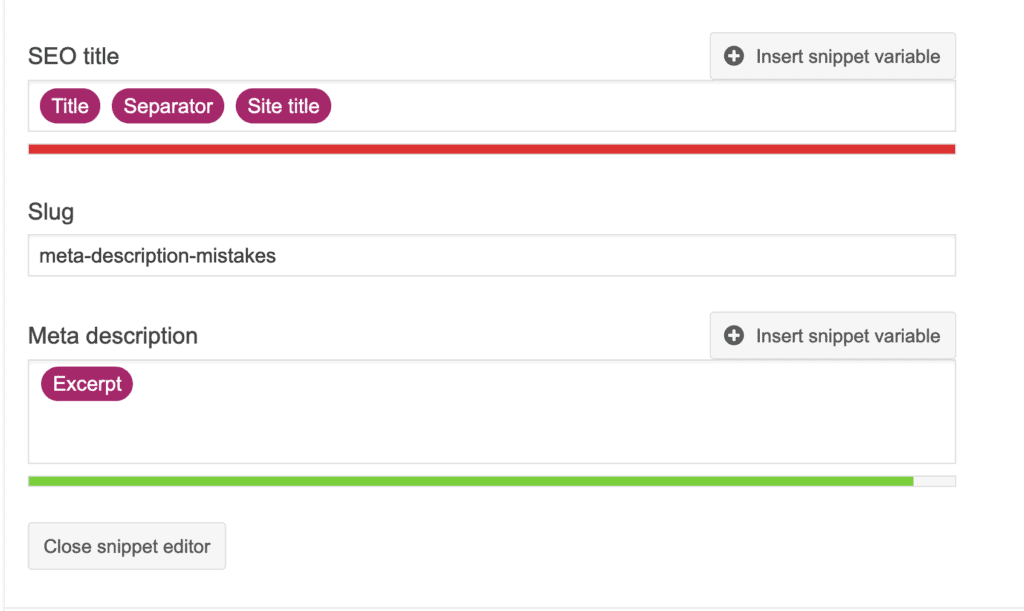I face the same problem every time I need to write a meta description.
I have no idea where to start.
Should I first mention the problem the article is solving? Should I use a call-to-action? Is it bad to repeat what I already wrote in the headline?
To find out, I analyzed hundreds of meta descriptions from the New York Times, Lonely Planet and other popular blogs.
The result is a list of 10 simple meta description templates you can use to create powerful meta descriptions no matter what niche you are in.
The Yoast meta description template

The Yoast meta description template is not like the others because it’s not a copywriting formula per se.
It’s simply the template the Yoast SEO plugin uses to generate a meta description if you don’t write one.
You can leave it blank if you’re sure you will never forget to write a meta description. Or you can use one of the following templates:
%%excerpt%%
This will use your post excerpt as a meta description. If none exists, it will take the first few paragraphs of your page.
%%excerpt_only%%
This will use your post excerpt as a meta description but won’t generate one if it’s missing.
Whether you use a Yoast meta description template or not, I recommend always writing a meta description.
Otherwise, Google will generate one for you which is likely to hurt your click-through rate (CTR.)
The teaser formula
The teaser formula is one of the favorite meta description formulas of sites like the New York Times.
It works by revealing enough to make the reader curious but not enough to fully satisfy his/her curiosity.
Think of it as the equivalent of your best friend telling you he just broke up with his girlfriend.
“I broke up with Laura” won’t cut it. You need more info. Well, it’s the same with the Description meta description template.
This works well for news and food-related articles because the reader will want to know more than just the facts.
To use this meta description formula, ask yourself:
- What interesting information does the article mention/reveal?
- Will the reader think: “tell me more” after reading the description?
The allegations suggest personal clashes influenced how the administration responded to the pandemic.
New York Times
Schmidt exited as a technical advisor at Google parent company Alphabet in February.
Cnet
The classic Mexican street food of grilled corn slathered in a creamy chili-, garlic-, and Cotija-spiked sauce.
Serious Eats
The “one more thing” formula
The “one more thing” meta description template is one I’m guilty of overusing because it’s incredibly simple, yet powerful.
Like Steve Jobs’ famous “one more thing” in Apple Keynotes, It leverages our tendency to always want more by offering an extra benefit.
https://www.youtube.com/watch?v=sdqMvEZTxlI&t=7s
To use this formula, mention the main benefit/promise of your article. Then another one.
“Compare top deals on 0% balance transfers, 0% purchases, cashback and rewards. Plus get exclusive deals you can’t get anywhere else”
MoneySuperMarket
The Call-to-action formula
This is another simple meta description template that works incredibly well.
All you need to do is think of the main benefit of your article and use an action verb to turn your meta description into a call-to-action.
This works well for content that offers a clear benefit and is commonly-used by comparison and shopping sites.
You can also use it for lifestyle and travel content by trying to make the reader feel as if they are already in the new reality your content promises.
To use it, ask yourself:
- What’s the main benefit of my article?
- What action do I want the reader to take once they are on the page?
Find the best credit card for you from the Which? Best Rate credit cards, including all the information you need on the types of credit cards available.
Which?
Check out the amazing examples in this tutorial on how to photograph the Milky way. There’s just something hypnotic about skygazing.
Light Stalking
Wander amongst breathtaking natural beauty and sample traditional customs in Tohoku, a less-visited part of northern Japan.
Lonely Planet
The question formula
According to Moz, roughly 8% of search queries are questions.
And your readers are likely asking themselves a ton of questions about your topic.
Using these questions in your meta description is a great way of showing that you understand them.
To use this formula, start by finding the right question to ask. This can be:
- A question your readers ask
- An intriguing question
- A rhetorical question your readers will answer positively
Then, promise to answer the question, either explicitly (with a CTA) or implicitly (by simply leaving the question unanswered in the meta description.)
Am I a monster? Probably! How one woman used the coronavirus quarantine to ghost her toxic friends.
Cosmopolitan
Ready to take your professional career to the next level? Check out five of the best digital marketing courses available today.
Search Engine Journal
To build wealth, you have to save a lot AND invest wisely. But which matters more for building wealth, your saving rate or your investment returns?
Get Rich Slowly
The problem-Solution formula

I love using the Problem-Solution formula in emails so I was delighted to see so many websites using it in their meta descriptions.
This meta description template works particularly well for “how-to” article because they tend to solve a clear problem.
To use it, start by mentioning a problem your readers have, then promise to offer a solution in the article.
- [Problem] + [Solution]
- [Problem] + [CTA Solution]
- [Problem] + [desired result/implied solution]
External sources link to your website with the wrong URLs, here’s how you can fix that.
Search Engine Land
Stuck at home? Check out these 12 famous museums that you can tour virtually from the comfort of your own home. Find all the best virtual tours here.
What to eat when you’re feeling down, out, or otherwise glum (and don’t want to feel that way anymore)
Into the gloss
The “why” formula
This formula is extremely simple.
- Ask why readers should read your article.
- Answer in the meta description.
This works well for food blogs because there are usually hundreds of similar recipes. Asking “why” is a great way to uncover your recipe’s uniqueness and stand out.
This Crockpot Chicken Wild Rice Soup is so darn simple to make and goes perfectly with a piece of crusty bread on a cold winter night.
Pinch of Yum
These Ruth Bader Ginsburg quotes are everything you need to feel inspired to make this Women’s History Month the most impactful yet.
Hello Giggles
This incredibly easy Rosemary Garlic White Bean Soup takes only eight simple ingredients to deliver a bowl full of rich, bold flavor
Budget Bytes
The transformation formula

We all love the idea of becoming more fit, feeling less stressed or speaking a foreign language.
And that’s what makes the transformation formula so powerful.
It doesn’t simply try to convince you to click and read the article, it promises to turn you into the person you have always wanted to be.
With this formula, you don’t sell your content, you sell the transformation it promises.
To use it, ask the following questions:
- What type of content is it? (checklist, in-depth guide…)
- What will it help the reader achieve?
Then use a phrase like “will help you…” to connect the content to the promise.
- [What your article contains] + [Will help you] [Transformation]
- [What your article contains] + [Will make you] [Transformation]
Everything you need to know about the “Rule of Thirds” in Photography - a simple principle that will help you to take well balanced and interesting photos.
Digital Photography School
These in-depth travel tips will help you always know how to travel cheaper, better, longer, and smarter. Learn to travel the word like an expert!
Nomadic Matt
Our ultimate guide to short celebrity hairstyles will help you find a haircut you’ll love
Byrdie
The Wikipedia formula
Wikipedia never uses meta descriptions.
Instead, they let Google generate one. Something Google mostly does by taking the beginning of each entry and using it as a meta description.
Unfortunately, you probably don’t have the authority and name recognition of Wikipedia so I don’t recommend doing the same.
But you could do something similar by taking the part of your article that best matches the search intent, and using it as a meta description.
This works well for informational queries such as “what is…?”
The key is to show the readers that your article answers their question by starting to answer right in the meta description.
To use it, ask yourself:
- What question is the reader asking?
- What’s the answer to this question?
This Atlantic Beach pie is commonly served at seafood restaurants on the North Carolina coast. Chef Bill Smith calls it the easiest pie recipe in the world.
Food52
The gossip formula

We are naturally drawn to gossip. In fact, scientists have found that gossiping is one of the key ways humans bond.
And while you have to be careful not to go too far, gossip can be a powerful tool in your meta description arsenal.
To use the gossip formula, think of a surprising opinion or fact that’s at the center of your article and mention it in your meta description.
This works well for opinion pieces and controversial articles.
The stronger the opinion or controversy, the more powerful the meta description.
My recent trip to Portugal (specifically Lisbon and Porto) left me pleasantly surprised. Portugal must be one of the most underrated tourist destinations.
One Mile at A Time
I’ve previously said Google’s Project Fi was the best international phone plan. Recent experiences have me withdrawing that endorsement.
One Mile at A Time
The agreement formula
The agreement formula is deceptively simple.
You start by stating a fact your readers agree with or want to believe in.
Then you use “here is” or “here are” to reveal the main benefit of the article.
It’s that simple.
The world is full of affordable places to visit! Here are ten best budget travel destinations that give you the most bang for your buck!
Nomadic Matt
The idea of travelling around Switzerland on the cheap might seem ludicrous, but it is possible. Here’s our guide to exploring Switzerland on a budget.
Lonely Planet
Small-business grants can be a viable source of financing for women-owned businesses. Here are 10 places to help you find small-business grants for women.
Nerd Wallet
Working on this article showed me that many of the top websites have a rather loose attitude to meta descriptions.
Many of them had meta descriptions that were way too long.
Some didn’t have meta descriptions at all.
This is a great opportunity for you to stand out.
So pick an article, choose the best formula, and use it to get more readers to your article!